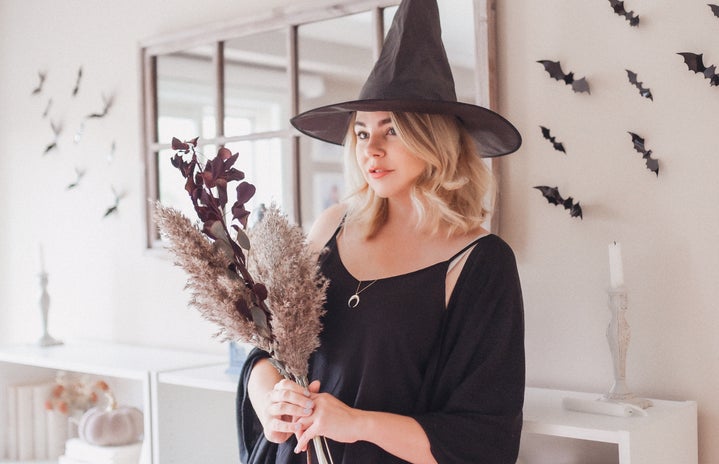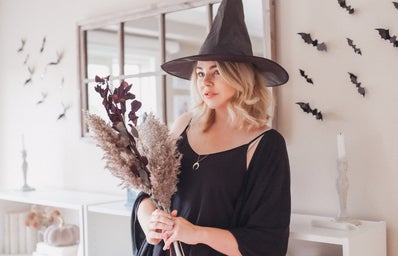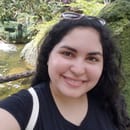When the term Halloween comes up, most people think of scary movies, trick or treating, dressing up, ghosts and witches. As I pondered what to write about concerning this spooky month, I thought of interviewing a friend of mine who practices witchcraft. Over the course of our friendship, I found out she belonged to a coven, and in her room she had spell books as well as a small altar, candles, incense, tarot cards, a small acrylic statue to represent the goddess, wine, an apple, and a collection of quartz crystals. Since Halloween is upon us, I wanted to interview her about what it’s like to be a witch; specifically, when exactly she became interested in witchcraft, how she found her coven and the types of rituals they practiced.
For starters, she wanted me to understand that there are various practices under witchcraft, and not every witch follows the same ones. She says she is a witch that practices pagan witchcraft. A misconception she often sees is that people tend to think that pagan witchcraft equals pentagram drawings and summoning the Devil; but rather, it’s called pagan because it consists of old customs. Some witches may say that one has to possess an innate gift to be a powerful witch. According to my friend, one does not have to be “gifted” to practice witchcraft, since it all has to do with one’s sensitivity to certain energies. As an example, she mentions the feeling one gets when walking into a room and how they might suddenly feel that something is off and you should leave. That is perceiving the energy of a place.
She shared that she also likes to consider herself an eclectic witch; which essentially means practicing rituals originating from other types of witchcraft, such as clairvoyance. It is a practice in and of itself but witchcraft has adopted it into one of its many customs, such as tarot reading.
Q: Can you tell me when it was that you started showing interest in witchcraft and how you met your coven?
“My experience with witchcraft started when I turned 13. As a middle school student, I always liked being alone and surrounded by nature. One day, I came across a Mexican magazine called “Tu” and it had a bunch of tips and spells of white magic, referring to spells that are used to attract good things such as prosperity and love, to name a few. After I read that, I started to look for books on witchcraft and practiced spells on my own. But it wasn’t until I had a very toxic relationship in college, whereupon I ended up in an institution that I met my spirit guide. A spirit guide is someone, a witch or a warlock, that decides to teach you what they know because they have gone through a similar experience that you have and they take you under their wing. When I entered the institution, my spirit guide was also there. One day, I was sitting by the window and he approached me saying that I was a witch. After a week, I asked him to teach me what he knows. He agreed. He turned out to be the priest of a coven that I later joined and gave classes Friday, Saturday and Sunday to other girls like myself.” She can’t say the name of the coven due to a privacy agreement.
“After 5 months in the coven, other high ranking members told me that I was ready to join them. The initiation was a ritual where I would stand in a magic circle during a full moon on the beach. After we celebrated the elements of earth, water, air and fire, they welcomed me as a newly reborn witch.”
She later showed me the syllabus that was given to her while she took her class to become a witch. It was surprisingly very long and one had to cover a lot of ground; including witchcraft history,how to perform certain rituals and how magic worked. I didn’t know the majority of the terms in the syllabus nor the papers she was given. They also had a worksheet where they had to make their own rituals, what each one’s goal was, what was needed, how to do it, whether it needed to be done at a specific time, during a specific moon phase, if you had to cleanse yourself beforehand, if a magic circle was needed, and if you had to invoke a God, a spirit or an ancestor, to name a few.
Q: Are there many titles in a coven, just like an association has a president, a treasurer and so on and so forth?
A: There are only two titles, the high priest and the high priestess, whom represent the God and Goddess in a magic circle. They’re in charge of the coven, and the other members are given a role as to who to summon during a ritual.
Q: Are there any dangerous rituals?
A: Yes. That’s why it’s so important to educate yourself in case it (a specific ritual) harms you. By harm, I mean karma. You have to remember the rule of three, which states that whatever we do, whether good or bad, will come back to us three times over. So we have to be careful. Also, it’s important to keep in mind the concept of free will, since there are a bunch of spells online that are created to control someone’s free will, such as to get back with a partner. No. Do not do that. That is bad. You are essentially interfering with someone’s free will. For witches, the main rule we have to follow is that we can do whatever we want, as long as we dont hurt anyone.
Q: Can you tell me about a ritual you’ve done?
A: Drawing down the moon. It’s very simple. It’s done during the full moon. That day we bring protective stones, candles in the color of every element, air is yellow, red is fire, earth is green and water is blue. Every color is a cardinal point; yellow is east, red is south, west is blue and north is green. There is also a candle for the god and goddess: the Goddess is silver and the God is gold. You first purify the magic circle where you will do your ritual. You trace the circle with your index finger, while holding a wand that measures from your middle finger all the way to your elbow. You then invoke the two Gods and invite them to your circle so they can protect the barrier between both worlds (the spiritual world and the physical world) by turning on their respective candles. Then you call down the guardians that protect the cardinal points by turning on each of their respective candles. Then we recite a poem for the God and Goddess and thank them for everything we learned that month. After that, we meditate by blessing crystals like quartz and giving them an intention. For example, this quartz will help me this month to get good grades on my exams. Then, in the circle we read each other’s tarots, try to read each other’s hands, then share the food we brought. Then we draw down the moon; which essentially means we siphon the Goddess’s energy that resides in the moon. For that, we need to absorb the moon’s light by visualizing we are bringing it down to Earth towards our physical bodies. Finally, we thank the guardians for coming to our ritual, we close the circle and we leave. While entering a circle, we always say “in perfect love and in perfect confidence”; and, upon leaving, state “happy meeting, happy departure and happy reunion”. This is what we call the Esbat celebration of the full moon.
She goes on to speak of other rituals she practices with her coven such as Mabon, which they perform to celebrate Fall. The altar always has to have something to represent the four elementsー incense for air, salt for earth, water for water and a candle for fire. In addition, two white candles to represent the God and the Goddess respectively, and a candle to represent the season that they are welcoming. Now that she no longer belongs to her coven, due to her moving away, she doesn’t practice as much as she used to. Nowadays, she considers herself a solitary witch that does rituals and spells alone.


